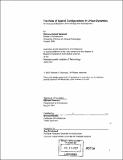The role of spatial configurations in urban dynamics : an analytical model for urban design and development
Author(s)
Varanasi, Kishore Venkat, 1974-
DownloadFull printable version (6.376Mb)
Alternative title
Urban design and development
Other Contributors
Massachusetts Institute of Technology. Dept. of Architecture.
Advisor
Michael Dennis.
Terms of use
Metadata
Show full item recordAbstract
The thesis explores the role of spatial configurations on the development of city form and the influence of these configurations on specific economic variables which govern the development of cities. It is argued that there are pervasive interconnections that seem to link the nature of society and economics with its spatial form and that economic theories must have some basis in a spatial theory. Based on this premise, this work investigates the logic of spaces and their network to derive an analytical spatial theory of intelligibility which is then built into a spatial-economic model of land values and densities. In urban land dynamics, location plays a significant role in determining the land values and density of development. Two important models namely Space Syntax and Ricardian rent mode, have been developed based on this assumption. This thesis adapts these models to generate a comprehensive dynamic spatial-economic model of cities. This new model will have predictive applications in spatial design as well as in urban development. It is proposed that the location in urban areas is determined by spatial configurations as well as commuting distance which is often used as a variable in economics to determine location. Relative asymmetry is proposed as a measure of relative location of a street segment in the system with respect to every other segment and as a function of intelligibility in any given physically contiguous configuration. Segments that are accessible and intelligible have location advantage. The differences in location value are then used to develop an econometric relationship between land values, density and relative asymmetry in a city. This yields a quantitative measure of an individual s preference for location and density.
Description
Thesis (S.M.)--Massachusetts Institute of Technology, Dept. of Architecture, 2001. Includes bibliographical references (p. 93-95).
Date issued
2001Department
Massachusetts Institute of Technology. Department of ArchitecturePublisher
Massachusetts Institute of Technology
Keywords
Architecture.